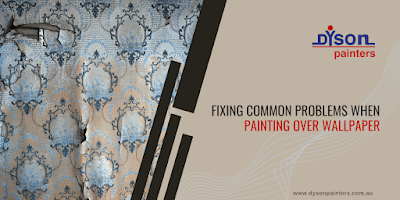Painting over wallpaper can be a practical solution to transform your walls without the hassle of stripping old wallpaper. However, without proper preparation and techniques, common problems like bubbling and peeling can arise. Here's how to tackle these challenges effectively and achieve a flawless finish.
Understanding the Issues
Painting over wallpaper is not without its challenges. The wallpaper’s texture, adhesive properties, and age can contribute to issues such as:
Blistering: Air pockets form under the wallpaper, causing unsightly bubbles.
Peeling: Sections of wallpaper lift away from the wall, disrupting the painted surface.
Uneven Surface: The seams and patterns of the wallpaper may remain visible through the paint.
Recognizing these potential problems beforehand will help you prepare and address them effectively.
Pre-Painting Preparation
Proper preparation is crucial for a successful wallpaper painting project. Follow these steps to set the foundation:
Inspect the Wallpaper: Ensure it is firmly adhered to the wall with no loose or peeling edges. Fix any damaged areas before proceeding.
Clean the Surface: Remove dust, grease, and grime using a mild detergent solution. Let the wallpaper dry completely.
Seal the Wallpaper: Apply a high-quality primer or sealer designed for wallpaper. This step prevents moisture from penetrating the wallpaper and causing bubbles.
Fill Seams: Use joint compound to smooth over seams or patterns, ensuring a flat and even surface.
Sand the Surface: Lightly sand the wallpaper to enhance adhesion and eliminate imperfections.
Dealing with Blisters
Blisters or bubbles are a common issue when painting over wallpaper. Here’s how to fix them:
Identify Problem Areas: Locate all bubbles after the first coat of paint or primer.
Pop the Bubble: Use a sharp utility knife to carefully cut a small slit in the bubble.
Apply Adhesive: Inject wallpaper adhesive into the slit and press the bubble down.
Smooth the Surface: Use a smoothing tool to eliminate air pockets and ensure the area is flat.
Re-prime and Paint: Once dry, apply primer and paint over the repaired section for a seamless look.
Preventing Peeling
Peeling can ruin your painted wallpaper project. To prevent this:
Test Adhesion: Check the wallpaper's bond to the wall before starting. If the adhesive is weak, reinforce it with additional glue.
Seal Edges: Apply clear caulk along the edges of the wallpaper to prevent lifting.
Avoid Excess Moisture: Use minimal water-based products and allow ample drying time between coats.
Final Touches
Achieving a professional finish requires attention to detail during the final steps:
Apply Multiple Coats: Use at least two coats of paint for even coverage. Opt for high-quality, durable paint.
Use Proper Tools: A roller ensures smooth application, while a brush is ideal for corners and edges.
Inspect and Touch Up: Once the paint dries, inspect the surface for imperfections and touch up as needed.
When to Call in Professionals
If the wallpaper is extremely old, damaged, or layered, or if you lack the time and tools for proper preparation, calling a professional painter is the best course of action. Experts like Dyson Painters have the skills and experience to manage complex wallpaper painting projects with ease.
Transform Your Walls with Expert Painting Over Wallpaper
Don’t let wallpaper hold you back from achieving your dream wall aesthetics. With the right preparation and techniques, you can paint over wallpaper successfully and enjoy a stunning transformation. For professional assistance and exceptional results, visit Dyson Painters.

Comments
Post a Comment